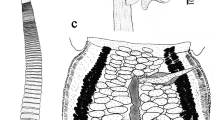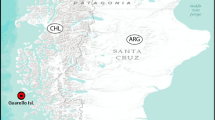Abstract
Specimens of four genetically distinct groups of Macropostrongyloides baylisi Wood, 1930 were analysed morphologically. Each genotype was found to represent a morphologically distinct species: Ma. baylisi from Osphranter robustus woodwardi (Thomas) and Osphranter robustus erubescens (Sclater); Ma. spearei n. sp. from Osphranter robustus robustus (Gould) and O. r. erubescens; Ma. mawsonae n. sp. from Macropus giganteus Shaw and Ma. woodi n. sp. from Osphranter rufus (Desmarest). The new species described here are differentiated primarily by several male-specific features that have been overlooked in previous taxonomic revisions. These features include striations on the terminal part of the spicule ala, the papillae surrounding the genital cone and the bursal striations. Furthermore, scanning electron photomicrographs have revealed greater details of previously undefined structures within the buccal cavity that warrant further investigations.











Similar content being viewed by others
References
Beveridge, I., & Mawson, P. M. (1978). A taxonomic revision of the genera Macropostrongyloides Yamaguti and Paramacropostrongylus Johnston & Mawson (Nematoda: Trichonematidae) from Australian marsupials. Australian Journal of Zoology, 26, 763–787.
Beveridge, I., Chilton, N. B., & Andrews, R. (1993). Sibling species within Macropostrongyloides baylisi (Nematoda: Strongyloidea) from macropodid marsupials. International Journal for Parasitology, 23, 21–33.
Beveridge, I. (2019). New species and a redescription of species of Cloacina von Linstow, 1898 (Nematoda: Strongyloidea) parasitic in macropodid marsupials. Transaction of the Royal Society of South Australia, 143, 188-–208.
Chabaud, A. G., Puylaert, F., Bain, O., Petter, A. J., & Durette-Desset, M.-C. (1970). Remarques sur lʼ homologie entre les papilles cloacales des Rhabditides et les côtes dorsales des Strongylida. Comptes Rendus Hebdomadaire des Séances de lʼAcadémie des Sciences, 271, 1771–1774.
ICZN (2012). International Commission on Zoological Nomenclature: Amendment of articles 8, 9, 10, 21 and 78 of the International Code of Zoological Nomenclature to expand and refine methods of publication. Bulletin of Zoological Nomenclature, 69, 161–169.
Jackson, S., & Groves, C. (2015). Taxonomy of Australian Mammals. Melbourne: CSIRO Publishing, pp. 501–529.
Mawson, P. M. (1977). Revision of the genus Macropostrongylus and descriptions of three new genera: Popovastrongylus, Dorcopsinema and Arundelia (Nematoda: Trichonematidae). Transactions of the Royal Society of South Australia, 101, 51–62.
Sukee, T., Beveridge, I., Chilton, N. B., & Jabbar, A. (2019). Genetic variation within the genus Macropostrongyloides (Nematoda: Strongyloidea) from Australian macropodid and vombatid marsupials. Parasitology, 146, 1673–1682.
Van Dyck, S., & Strahan, R. (2008). The mammals of Australia (3rd ed.). Chatswood: New Holland Publishers, pp. 335–354.
Wood, W. A. (1930). Some new parasitic nematodes from Western Australia. Report of the Director, University of Cambridge Institute of Animal Pathology, 1929-30, 209–219.
Yamaguti, S. (1961). Systema Helminthum. Volume III. The Nematodes of Veterbrates. New York: Interscience Publishers, pp. 384–385.
Acknowledgements
We would like to thank Dr Allison van de Meena from the Biosciences Microscopy unit, Melbourne University for her advice and assistance with the scanning electron microscopy. This study was financially supported by the Australian Biological Resources Study grants RF217–06 and CBG18–07.
Author information
Authors and Affiliations
Corresponding author
Ethics declarations
Conflict of interest
The authors declare that they have no conflict of interest.
Ethical approval
Specimens were collected under the following state-issued permits: Victorian Department of Sustainability and Environment 90-053, 93-016, 10000434, 100003649; Queensland National Parks and Wildlife Service T00436, T1131, Queensland Department of Environment and Heritage Protection WA 00006125, the Northern Territory Department of Primary Industry 15747, the Western Australian Department of Environment and Conservation SF007407 and the South Australian Department of Environment and Heritage EO7358.
Additional information
Publisher's Note
Springer Nature remains neutral with regard to jurisdictional claims in published maps and institutional affiliations.
This article was registered in the Official Register of Zoological Nomenclature (ZooBank) as urn:lsid:zoobank.org:pub:47AA7500-998A-48A3-AD7B-78A3BB338ADD. This article was published as an Online First article on the online publication date shown on this page. The article should be cited by using the doi number. This is the Version of Record.
This article is part of the Topical Collection Nematoda.
Rights and permissions
About this article
Cite this article
Sukee, T., Beveridge, I. & Jabbar, A. New species of Macropostrongyloides Yamaguti, 1961 (Nematoda: Strongylida) and the redescription of Ma. baylisi (Wood, 1930) from Australian macropodid marsupials. Syst Parasitol 97, 267–284 (2020). https://doi.org/10.1007/s11230-020-09914-8
Received:
Accepted:
Published:
Issue Date:
DOI: https://doi.org/10.1007/s11230-020-09914-8




